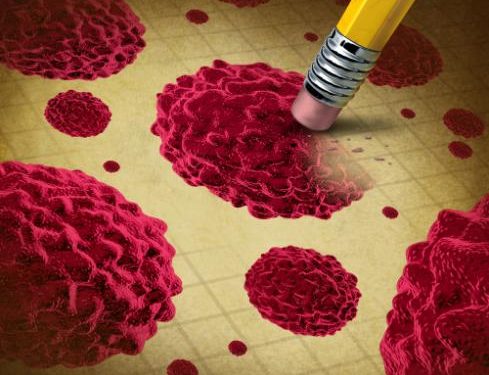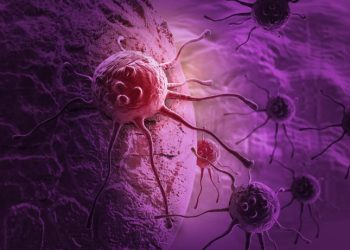Sarcoma is a type of cancer that starts in bone or soft tissue (cartilage, fat, muscle, blood vessels or fibrous tissue). It can also spread to nearby organs and tissues.
The most common sign is a painless lump or swelling that grows quickly and may press on nerves, muscles or blood vessels. Your doctor can diagnose sarcoma using special tests.
Risk factors
July is Sarcoma Awareness Month, and while the exact cause of this rare cancer isn’t known, there are certain risk factors that can increase the likelihood of developing sarcoma. These include prior radiation exposure, genetic disorders, long-term swelling (lymphedema) and exposure to certain chemicals.
A cancerous sarcoma forms when cells in soft tissue, such as nerves, muscles, fat, blood vessels and skin tissues, grow abnormally and form tumors. Most sarcomas form in the bone or soft tissue of the arms and legs, but they can also develop in the chest, abdomen and head and neck. It is estimated that sarcomas affect about 13,000 people in the United States each year.
The most common risk factor for sarcoma is having been treated with radiation for another cancer, which increases the chance of developing a sarcoma in the area of the body that received the radiation. This is especially true if the radiation was delivered at high doses and over a large area. However, it is important to note that radiation therapy used for other types of cancers is very precise and does not damage healthy tissue.
Certain genetic disorders, such as Gardner syndrome and Werner syndrome, can increase the chances of developing a sarcoma. Some inherited conditions, such as Li-Fraumeni syndrome and familial retinoblastoma, can also increase the chance of getting osteosarcoma, a type of bone cancer.
Other risk factors for sarcoma include smoking, having a family history of cancer and exposure to certain chemicals. Some industrial chemicals, such as vinyl chloride, can increase the chance of getting some sarcomas. This is particularly true if the person worked with this chemical in high amounts for many years.
Other risks for sarcoma include a viral infection, human immunodeficiency virus (HIV) and herpes simplex virus (HSV). HIV and HSV can both lead to Kaposi’s sarcoma, which is a rare type of sarcoma that develops in the blood and lymph vessels. HSV can also cause angiosarcoma, a rare type of sarcoma. HSV infections occur mostly in people who have an immune system that is weakened by illness or medication.
Symptoms
Sarcoma is a cancer that develops in the body’s connective tissue, which includes bone, cartilage, fat, muscle and nerves. It can start anywhere in the body, and usually grows as a painless lump or swelling. The type of sarcoma and where it starts determines the symptoms it causes.
When sarcoma grows in the arms or legs, it is more likely to cause pain, swelling and changes in the skin color. If it starts in the abdomen, it may cause a painless lump that grows over time and presses on nearby organs and blood vessels. When sarcoma begins in the uterus, it is more likely to cause a painful menstrual period and change in the shape of the uterus.
Other symptoms depend on the location of the sarcoma. A sarcoma in the bones can grow to enlarge a bone and lead to pain, difficulty walking or loss of movement in a joint. The type of sarcoma also determines its grade, which describes how much the cells look like normal tissue and what speed the tumor grows at. A lower grade is easier to treat than a higher one.
If you have the signs and symptoms of a sarcoma, it is important to see your doctor right away. The sooner it is diagnosed, the better your chances are of a successful treatment.
Your doctor will do tests to find out if you have a sarcoma. They may use X-rays, MRI (magnetic resonance imaging), CT scans or PET (positron emission tomography) scans. They will also do a biopsy of the tumor. Your provider will send the biopsy to a laboratory so a specialist can analyze the tissue and check for sarcoma.
If a sarcoma is caught early, when it is in a low-grade, it can be treated to cure you. But if it’s discovered later, when it is in a high-grade or has spread to other parts of the body, you may have a harder time getting a cure. This is because it’s more difficult to remove a large, high-grade tumor from the body than it is to remove a smaller, lower-grade tumor.
Diagnosis
The first step to diagnosing a sarcoma is for a healthcare provider to ask about your symptoms and examine the lump or swelling. They may also order an imaging test, such as an x-ray, CT scan or an MRI, to find out what the mass is made of and where it is located. Because sarcomas can form in bone, soft tissue or blood vessels and can appear anywhere in the body, they are hard to recognize. They often look like other types of bumps and growths, such as a hernia, ganglion cyst or a benign fat tumor (lipoma). As a result, sarcomas are frequently misdiagnosed.
A sarcoma is best diagnosed by a specialist in this type of cancer at a specialty center. Because sarcomas can be difficult to distinguish from other kinds of tumors, it is especially important to have an accurate diagnosis before treatment begins.
When a healthcare professional is suspicious that a lump or bump might be a sarcoma, they may do a fine needle aspiration (FNA) or core needle biopsy to get a small sample of the growth. They then send the sample to a lab to be analyzed. A pathologist, a doctor who specializes in analyzing tissue samples, can identify the type of sarcoma that is present.
If a sarcoma is diagnosed, further tests may be done to learn more about the size and location of the tumor and whether it has spread. This is called staging. Your healthcare provider will also use the results of the biopsy to determine what type of sarcoma you have and its grade. The higher the grade, the more likely the cancer is to grow quickly and spread.
Your healthcare provider may recommend radiation therapy to kill any remaining cancer cells. It may be given before or after surgery or both. Depending on what type of sarcoma you are diagnosed with, chemotherapy is also sometimes used to treat it. Chemotherapy uses strong medicines to kill cancer cells. It is often given through a vein, but can be taken in pill form.
Treatment
A sarcoma starts in your body’s connective tissue, which includes muscle, bone, fat and nerves. When the cells in this tissue go haywire and divide too quickly, they can grow out of control and form a tumor. These growths can happen anywhere in your body, but most often develop in the arms and legs. It is not clear why some people develop these growths while others don’t.
Sarcomas can be very hard to treat, especially if they have spread by the time they are detected. But if they are caught early, before they grow too large, they may respond to treatment.
Your healthcare provider will take a medical history and do a physical examination, including feeling for any lumps. You will also have imaging tests to see where the sarcoma is and what it looks like. These tests can include a CT scan or an MRI to help find out where the sarcoma is. You may also have a PET scan, which is a type of nuclear medicine test that combines a radioactive substance with glucose to show areas where the cells in your body are using up lots of energy (like cancer cells).
If you are diagnosed with soft tissue sarcoma, your healthcare provider will probably recommend surgery. The surgeon will remove the sarcoma and some healthy tissue around it. They may need to do a wider operation if the sarcoma is closer to bones, muscles or vascular structures. They may also need to take a sample of the sarcoma for further testing in a lab.
Chemotherapy is a type of treatment that uses drugs to kill cancer cells or stop them from growing. Your healthcare provider may give you chemotherapy pills or they may be injected directly into your bloodstream. They may also use other types of treatments, such as radiation or biologic agents.
If the sarcoma has spread to other parts of your body, your healthcare provider will recommend treatment that is designed to target the cancer in those areas. This treatment is usually more intense than treatment for sarcoma that has not spread.









